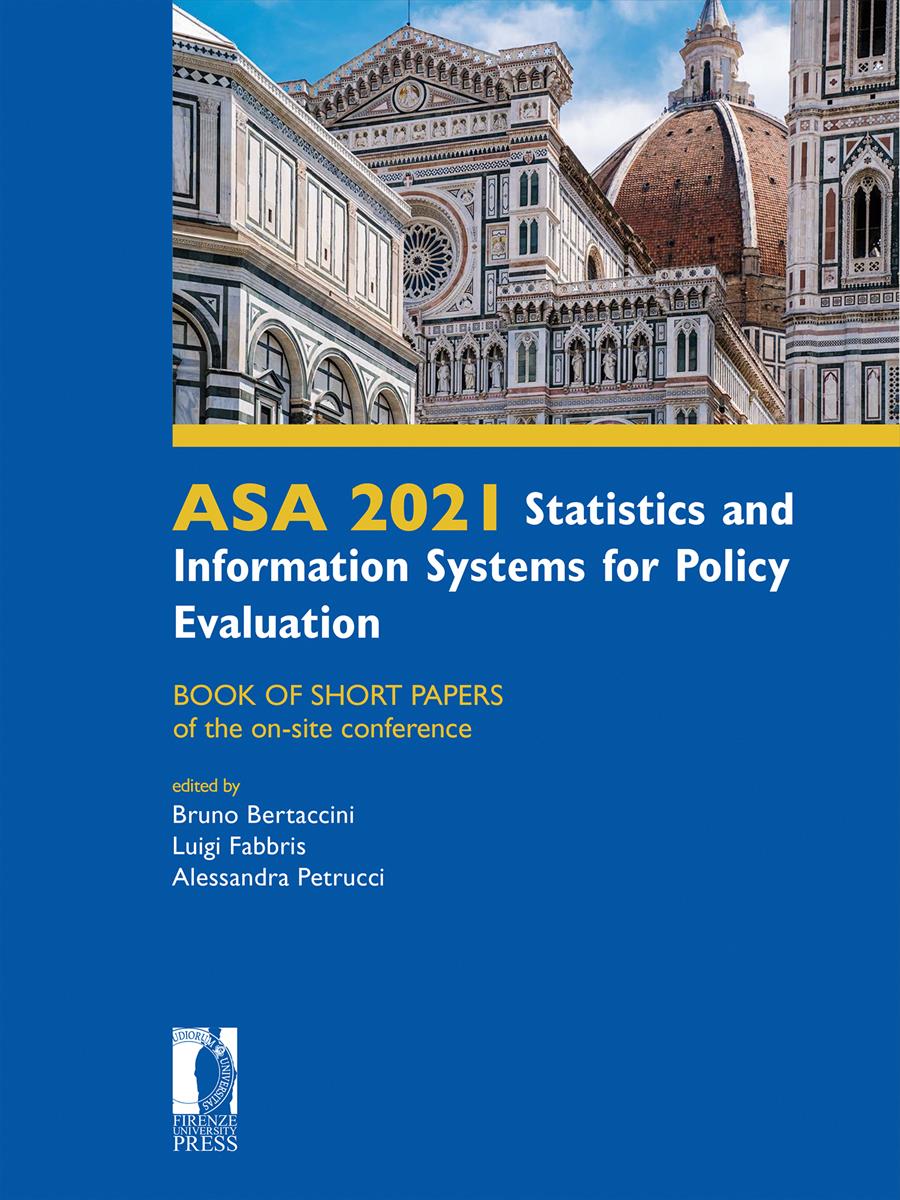- ASA 2021 Statistics and Information Systems for Policy Evaluation
- Edited by Bruno Bertaccini, Luigi Fabbris, Alessandra Petrucci
A Prospective Sustainability Indicator for Pension Systems
- Fabrizio Culotta
- © 2021 Author(s) |
- CC BY 4.0
- DOI: 10.36253/978-88-5518-461-8.39
This work proposes an informative system to monitor pension systems by integrating pension and labor market statistics. This more comprehensive system is used to build an indicator to measure prospectively the sustainability of pension systems. The set of indicators is divided into two groups, each tracking pension contributions and payments flows. Each flow is composed by the product of three statistics: a statistics for the extensive margin, i.e. how many contributors and retirees, one for the intensive margin, i.e. how much workers contribute and pensioners receive pensions, and one for the durational margin, i.e. for how long workers contribute and retirees receive pensions. As such, the statistical content is coherent with the set of pension indicators considered by Eurostat and OECD. Statistics are extracted from Eurostat database and ensure cross-country comparability. The advantage of this approach is twofold. Firstly, it allows reflecting specificities of each pension regimes, characterized by own specific contribution rules and pension formulas, without explicitly account for them. Secondly, it allows to relate the assessment of sustainability of pension systems to the dynamics of labor markets since it explicitly takes into account the distribution of wages, the duration of working life, the distribution of old-age pensions and the life expectancy at retirement. An application on a pool of seven European countries (Austria, Finland, France, Germany, Italy, the Netherlands) is provided for the period 2015 - 2019. The indicator for the prospective sustainability of pension systems is compared across two other alternatives to stress the contribution of each margin. These alternatives are then compared with a benchmark indicator and their correlations are measured.
- Keywords:
- Pension Systems,
- Labor Market,
- Sustainability,
- Indicators,
University of Genoa, Italy - ORCID: 0000-0002-3910-3088
- Bravo, J. M., & Herce, J. A. (2020). Career breaks, Broken pensions? Long-run effects of early and late-career unemployment spells on pension entitlements. Journal of Pension Economics & Finance, 1-27.
- Holzmann, R. (2005). Old-age income support in the 21st century: An international perspective on pension systems and reform. World Bank Publications.
- Mercer, Melbourne (2015). Melbourne Mercer Global Pension Index.
- Mercer, Melbourne (2016). Melbourne Mercer Global Pension Index.
- Mercer, Melbourne (2017). Melbourne Mercer Global Pension Index.
- Mercer, Melbourne (2018). Melbourne Mercer Global Pension Index.
- Mercer, Melbourne (2019). Melbourne Mercer Global Pension Index.
- Whitehouse, E. (2012). Pension indicators: reliable statistics to improve pension policymaking (No. 70347, pp. 1-12). World Bank Publications.
Chapter Information
Chapter Title
A Prospective Sustainability Indicator for Pension Systems
Authors
Fabrizio Culotta
Language
English
DOI
10.36253/978-88-5518-461-8.39
Peer Reviewed
Publication Year
2021
Copyright Information
© 2021 Author(s)
Content License
Metadata License
Bibliographic Information
Book Title
ASA 2021 Statistics and Information Systems for Policy Evaluation
Book Subtitle
BOOK OF SHORT PAPERS of the on-site conference
Editors
Bruno Bertaccini, Luigi Fabbris, Alessandra Petrucci
Peer Reviewed
Publication Year
2021
Copyright Information
© 2021 Author(s)
Content License
Metadata License
Publisher Name
Firenze University Press
DOI
10.36253/978-88-5518-461-8
eISBN (pdf)
978-88-5518-461-8
eISBN (xml)
978-88-5518-462-5
Series Title
Proceedings e report
Series ISSN
2704-601X
Series E-ISSN
2704-5846
